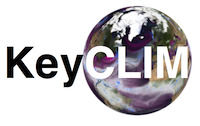WP7 preforms in-depth analysis of enhanced NorESM simulations of WP6 focusing on coupled feedbacks leading to potentially irreversible climate change. Key tasks include:
1. To quantify how enhanced lateral resolution in our ocean model improves the representation of mesoscale eddies and of climate at high northern latitudes. This work extends to the quantification of changes in deep water formation in regions of open sea convection and on the Arctic continental shelves.
2. We analyze the first coupled ice sheet-climate simulations with our model. This work addresses how increased continental freshwater runoff from the shrinking Greenland ice sheet impacts the ocean circulation and potentially compounds the effect of rising greenhouse gas emissions.
3. A task on carbon chemistry in the ocean quantifies how the enhanced vertical resolution in the uppermost layers of the ocean changes air-sea exchanges, and therefore the representation of primary production and the carbon sink in the ocean.
4. We synthesize and summarize how the collective effect of the numerous improved processes in NorESM shape our understanding of northern high latitude climate change under high emission scenarios. This task aims to quantify the limits of reversible climate change and how the enhanced NorESM provides a better answer to the key question: What is dangerous climate change and what emissions are compatible with avoiding it?





